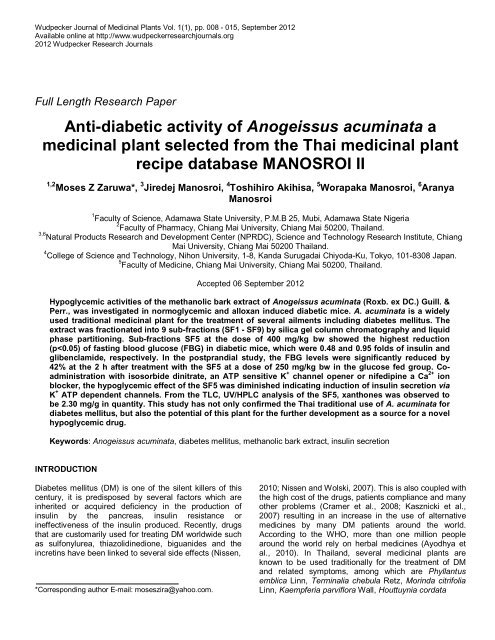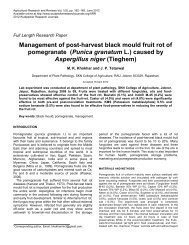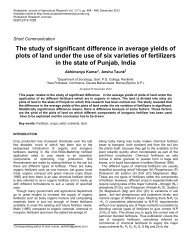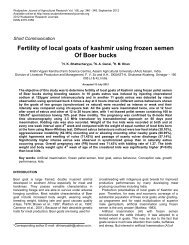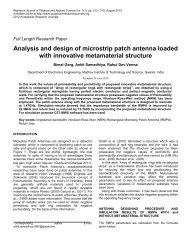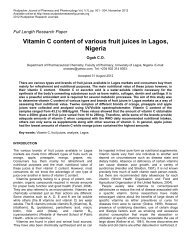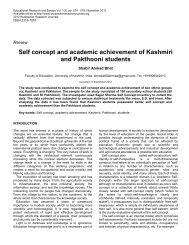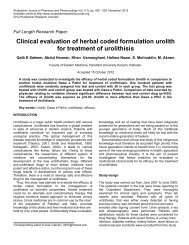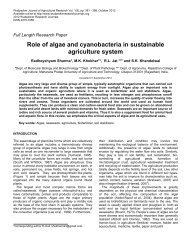Anti-diabetic activity of Anogeissus acuminata a medicinal plant ...
Anti-diabetic activity of Anogeissus acuminata a medicinal plant ...
Anti-diabetic activity of Anogeissus acuminata a medicinal plant ...
You also want an ePaper? Increase the reach of your titles
YUMPU automatically turns print PDFs into web optimized ePapers that Google loves.
Wudpecker Journal <strong>of</strong> Medicinal Plants Vol. 1(1), pp. 008 - 015, September 2012<br />
Available online at http://www.wudpeckerresearchjournals.org<br />
2012 Wudpecker Research Journals<br />
Full Length Research Paper<br />
<strong>Anti</strong>-<strong>diabetic</strong> <strong>activity</strong> <strong>of</strong> <strong>Anogeissus</strong> <strong>acuminata</strong> a<br />
<strong>medicinal</strong> <strong>plant</strong> selected from the Thai <strong>medicinal</strong> <strong>plant</strong><br />
recipe database MANOSROI II<br />
1,2 Moses Z Zaruwa*, 3 Jiredej Manosroi, 4 Toshihiro Akihisa, 5 Worapaka Manosroi, 6 Aranya<br />
Manosroi<br />
1 Faculty <strong>of</strong> Science, Adamawa State University, P.M.B 25, Mubi, Adamawa State Nigeria<br />
2 Faculty <strong>of</strong> Pharmacy, Chiang Mai University, Chiang Mai 50200, Thailand.<br />
3,6 Natural Products Research and Development Center (NPRDC), Science and Technology Research Institute, Chiang<br />
Mai University, Chiang Mai 50200 Thailand.<br />
4 College <strong>of</strong> Science and Technology, Nihon University, 1-8, Kanda Surugadai Chiyoda-Ku, Tokyo, 101-8308 Japan.<br />
5 Faculty <strong>of</strong> Medicine, Chiang Mai University, Chiang Mai 50200, Thailand.<br />
Accepted 06 September 2012<br />
Hypoglycemic activities <strong>of</strong> the methanolic bark extract <strong>of</strong> <strong>Anogeissus</strong> <strong>acuminata</strong> (Roxb. ex DC.) Guill. &<br />
Perr., was investigated in normoglycemic and alloxan induced <strong>diabetic</strong> mice. A. <strong>acuminata</strong> is a widely<br />
used traditional <strong>medicinal</strong> <strong>plant</strong> for the treatment <strong>of</strong> several ailments including diabetes mellitus. The<br />
extract was fractionated into 9 sub-fractions (SF1 - SF9) by silica gel column chromatography and liquid<br />
phase partitioning. Sub-fractions SF5 at the dose <strong>of</strong> 400 mg/kg bw showed the highest reduction<br />
(p
009 Agric. Med. Plants.<br />
Thunb (Kusirin et al., 2009) and <strong>Anogeissus</strong> <strong>acuminata</strong><br />
(Roxb. ex DC.) Guill. & Perr. (Zaruwa et al., 2009). All <strong>of</strong><br />
these <strong>plant</strong>s appear in the MANOSROI II database<br />
<strong>of</strong> the Natural Product Research and Development<br />
Center (NPRDC). The hypoglycemic efficiency <strong>of</strong> the<br />
aqueous extract <strong>of</strong> A. <strong>acuminata</strong> has earlier been<br />
observed to be over 70% in <strong>diabetic</strong> mice and was<br />
comparable to insulin with five folds free radical<br />
scavenging <strong>activity</strong> <strong>of</strong> ascorbic acid (Manosroi et al.,<br />
2011). Apart from DM treatment, A. <strong>acuminata</strong> has been<br />
used in the treatment <strong>of</strong> painful inflammatory conditions<br />
in India (Hemamalini et al., 2010), anti-HIV <strong>activity</strong><br />
(Rimando et al., 1994) and anti-snake venom (Dahare<br />
and Jain, 2010). This study investigated the<br />
hypoglycemic effect <strong>of</strong> A. <strong>acuminata</strong> sub-fractions and<br />
the sub-fraction with the highest hypoglycemic effect was<br />
further investigated for other biological activities and<br />
mechanism <strong>of</strong> action.<br />
MATERIALS<br />
The bark <strong>of</strong> A. <strong>acuminata</strong> was collected from Mae Fa<br />
Luang (Akha Lahu) village, Chiang Rai, Thailand at an<br />
elevation <strong>of</strong> 975 m in February, 2009 by Mr. J. F. Maxwell<br />
<strong>of</strong> the Chiang Mai University Herbarium. Two voucher<br />
specimens (Voucher No. 09 to 41) were deposited at the<br />
CMU Herbarium, Faculty <strong>of</strong> Science and at the Faculty <strong>of</strong><br />
Pharmacy Herbarium, Chiang Mai University. The bark <strong>of</strong><br />
A. <strong>acuminata</strong> was air dried under shade prior to milling<br />
and extraction. Other materials used are Finetest<br />
Glucometer (Infopia Co., Ltd., Korea), stainless steel mill<br />
(Hiplan Associates, Thailand), rotary evaporator (Buchi,<br />
Switzerland), silica gel (Merck, Darmstadt, Germany).<br />
Drugs and chemicals Insulin (Boehringer Ingelheim,<br />
Germany), glibenclamide (Glb) and normal saline<br />
(Government Pharmaceutical Organization, Bangkok,<br />
Thailand), nifedipine, isosorbide dinitrate (Berlin<br />
Pharmaceutical Co. Ltd, Bangkok, Thailand) and alloxan<br />
monohydrate (Sigma-Aldrich, St Louis Mo, USA) and<br />
methanol (RCI L, Bangkok, Thailand) were used as<br />
received. All other chemicals were <strong>of</strong> analytical grade.<br />
Extraction and fractionation<br />
The semi-dried bark <strong>of</strong> A. <strong>acuminata</strong> was further dried in<br />
a hot air oven and pulverized using a stainless steel mill.<br />
The powdered bark (650g) was extracted by soxhlet<br />
extraction with 3,000 ml 80% v/v method. The crude<br />
methanol filtrate was filtered and evaporated under<br />
reduced pressure. The crude methanolic extract was<br />
dissolved in chlor<strong>of</strong>orm (2,000 ml) and the chlor<strong>of</strong>orm<br />
solution was filtered and evaporated under reduced<br />
pressure, while the methanol residue was also collected<br />
and dried by evaporation. The methanol residue was<br />
dissolved in water and fractionated by liquid phase<br />
partition with ethyl acetate, n-butanol and methanol to<br />
obtain the sub-fractions SF2, SF4 and SF5, respectively.<br />
All sub-fractions were evaporated under reduced<br />
pressure. The chlor<strong>of</strong>orm extract was loaded onto<br />
silica gel column and fractionated using chlor<strong>of</strong>orm,<br />
chlor<strong>of</strong>orm-methanol (9:1) and methanol to obtain the<br />
sub-fractions SF7, SF8 and SF9, respectively. The<br />
eluates were collected according to each band and<br />
evaporated under reduced pressure by a rotary<br />
evaporator. The extraction scheme <strong>of</strong> A. <strong>acuminata</strong> subfractions<br />
and their yield are shown in Figure 1.<br />
Experimental animals<br />
ICR mice <strong>of</strong> both sexes (22 to 28g, 9 to 12weeks) were<br />
purchased from Animal Center, Mahidol University,<br />
Bangkok, Thailand. The mice were fed with standard<br />
feed, water ad libitum and maintained under standard<br />
conditions <strong>of</strong> temperature, humidity and light (25 + 2 0 C;<br />
70% RH and 12 h light/dark).<br />
Ethical clearance<br />
All methods used were ethically approved by the Chiang<br />
Mai University’s Animal Ethics Committee. Protocol<br />
Number: 40/2552.<br />
Induction <strong>of</strong> diabetes mellitus<br />
Diabetic mice were produced by intravenous injection <strong>of</strong><br />
10% w/v alloxan monohydrate in normal saline solution<br />
(75 mg/kg bw) via tail vein after 18 h fasting as described<br />
by Manosroi et al., (2011).<br />
Hypoglycemic studies<br />
The sub-fractions <strong>of</strong> A. <strong>acuminata</strong> were administered to<br />
groups (n = 5) <strong>of</strong> normoglycemic or alloxan induced<br />
<strong>diabetic</strong> ICR mice at the doses <strong>of</strong> 100, 200 and 400<br />
mg/kg bw using a feeding tube after 18 h fasting (Moufid,<br />
2009) and monitored over a 4 hour period as described<br />
by Manosroi et al., (2011). Fasting blood glucose (FBG)<br />
was assayed from the tail vein blood <strong>of</strong> the mice using<br />
Finetest Glucometer. The effect <strong>of</strong> each extract was<br />
compared with standard hypoglycemic drugs, insulin and<br />
glibenclamide.<br />
Oral glucose tolerance test (OGTT)<br />
OGTT was performed by using the modified methods as<br />
described by Wu et al., (2011). Briefly, groups <strong>of</strong> 5<br />
normal mice were fasted for 18 h and fed orally with DW
Zaruwa et al. 010<br />
Figure 1. Extraction scheme <strong>of</strong> A. <strong>acuminata</strong> fractions and sub-fractions (SF) using silica gel column chromatography (c.c.) and<br />
liquid phase partition (LPP). SF1: methanol extract, SF6: chlor<strong>of</strong>orm extract; SF2: ethyl acetate, SF3: chlor<strong>of</strong>orm, SF4: butanol, SF5:<br />
methanol, SF7: chlor<strong>of</strong>orm, SF8: chlor<strong>of</strong>orm-methanol, SF9: methanol sub-fractions.<br />
or SF5, the sub-fraction which showed the highest<br />
hypoglycemic <strong>activity</strong>. After two hours, different<br />
carbohydrates were administered orally, namely; glucose<br />
(2.5 g/kg), sucrose (2.5 g/kg), corn starch (6 g/kg) and<br />
lactose (6 g/kg) as described by Wu et al., (2011). The<br />
blood glucose levels were tested at 0, 1, 2, 3 and 4 h.<br />
Insulin (0.5 iu) and glibenclamide (Glb) (1 mg/kg bw, oral)<br />
was used as control.<br />
Mechanistic studies (Co-treatment with Ca + and K +<br />
ion channel regulators)<br />
Normoglycemic mice were divided into four groups (n =<br />
5) as follows: 1. Normal control (NC) (ip) group: treated<br />
with 0.5 ml normal saline (NSS). 2. Treated with the SF5<br />
at 250 mg/kg bw in combination with normal saline (po).<br />
3. SF5N: the same treatment as group 2 plus nifedipine<br />
(N) 13.6 mg/kg (po). 4. SF5I: the same treatment as<br />
group 2 plus isosorbide dinitrate (I) 6.8 mg/kg (po). FBG<br />
was assayed from the tail vein blood <strong>of</strong> the mice using<br />
Finetest Glucometer at 0, 2, 4 and 6 h after treatment.<br />
Comparison <strong>of</strong> FBG after intraperitoneal injection and<br />
oral administration <strong>of</strong> the sub-fractions in <strong>diabetic</strong><br />
mice<br />
In order to evaluate the most effective route <strong>of</strong><br />
administration <strong>of</strong> the SF5, <strong>diabetic</strong> mice were divided into<br />
five groups (n = 5) and treated as follows:<br />
1. The negative control group: given (po) distilled water<br />
(DW).<br />
2. The positive control group I: Injected – (ip) with 0.5<br />
iu/kg insulin (Ins).<br />
3. The positive control group II: given (po) with 1.0 mg/kg<br />
bw <strong>of</strong> glibenclamide (Glb).<br />
4. Treated group A: received (ip) with the SF5 dispersed<br />
in DW (62.5 mg/kg bw).<br />
5. Treated group B: given SF5 dispersed in DW (120<br />
mg/kg bw). FBG was monitored at 0, 1, 2, 3 and 4 h post<br />
treatment.<br />
TLC, UV and HPLC analysis <strong>of</strong> the M SF5<br />
Preliminary analysis <strong>of</strong> the phytochemical constituents in<br />
the SF5 using TLC sprayed with 10% H 2 SO 4 or FeCl 3<br />
was performed together with HPLC analysis. 10 mg <strong>of</strong><br />
the SF5 was dissolved in DW (1 ml) and filtered through<br />
0.45 µm membrane filter. 0.75 ml <strong>of</strong> the filtrate was<br />
analyzed on a UV visible spectrophotometer (Shimadzu,<br />
Japan) to scan for a suitable spectral wave length for<br />
further analysis. 1 ml <strong>of</strong> the filtered solution was<br />
transferred into an amber bottle for HPLC analysis. In<br />
HPLC analysis, Gemini– Nx 5µ C18 110A, 250 x4.60mm<br />
column (Thermo Finnigan-Auto sampler, U.S.A) was<br />
used. The mobile phase was 40% methanol in DW using<br />
an isocratic program for 45 mins with the flow rate <strong>of</strong> 0.8<br />
ml/min at 218 nm. 5 mg <strong>of</strong> Mangosteen bark (powder)<br />
(Jujun et al., 2009; Walker, 2007) dissolved in 40%<br />
methanol was used as a standard reference.
011 Agric. Med. Plants.<br />
Data analysis<br />
The results are expressed as mean ± SEM and<br />
compared by means <strong>of</strong> student’s t test. Values were<br />
considered statistically significant at p
Zaruwa et al. 012<br />
Figure 2. Hypoglycemic effects in normoglycemic mice <strong>of</strong> various A. <strong>acuminata</strong> sub-fractions which<br />
demonstrated the decrease in FBG. Values were mean ± SEM <strong>of</strong> five mice (n=5). *:Significant<br />
reduction <strong>of</strong> FBG (p
013 Agric. Med. Plants.<br />
Figure 4. Hypoglycemic effect <strong>of</strong> the SF5 on postprandial blood glucose (PPBG) levels <strong>of</strong> normoglycemic mice. The carbohydrates were<br />
given 2 h after being fed with SF5 (250 mg/kg bw) or glibenclamide (1.00 gm/kg bw). *p
Zaruwa et al. 014<br />
Figure 6. Effect <strong>of</strong> calcium (nifedipine) and potassium (isosorbide) channel regulators on hypoglycemic <strong>activity</strong> <strong>of</strong> the SF5 in<br />
normoglycemic mice (NM). NM fed with distilled water only, SF5: fed with 250 mg/kg ip, SF5N: the SF5 at 250 mg/kg ip plus<br />
nifedipine (13.6 mg/kg-po), SF5I: treated with the SF5 (250 mg/kg-ip) plus isosorbide dinitrate (6.8 mg/kg, po). *p
015 Agric. Med. Plants.<br />
<strong>of</strong> Diabetic rats. Int. J. Pharmacol., 3: 143-148.<br />
Ayodhya S, Kusum S, Anyali S (2010). Hypoglycemic<br />
<strong>activity</strong> <strong>of</strong> different extracts <strong>of</strong> various herbal <strong>plant</strong>s. Int.<br />
J. Res. Ayurveda and Pharm., 1: 212-224.<br />
Bnouham M, Ziyyat A, Meklifi H, Tahri A, Legsseyer A<br />
(2006). Medicinal <strong>plant</strong>s with potential anti<strong>diabetic</strong><br />
<strong>activity</strong>. A review <strong>of</strong> ten years <strong>of</strong> herbal <strong>medicinal</strong><br />
research (1990 – 2000). Int. J. Diab. Metab., 14: 1-25.<br />
Cramer JA, Benedict A, Muszbek N, Keskinasian A, Khan<br />
ZM (2008). The significance <strong>of</strong> compliance and<br />
persistence in the treatment <strong>of</strong> diabetes,<br />
hypertension and dyslipidaemia: a review. Int. J. Clin.<br />
Pract., 62: 76-87.<br />
Dahare DK, Jain A (2010). Ethnobotanical studies on<br />
<strong>plant</strong> resources <strong>of</strong> Tahsil Multai, District Betul,<br />
Pradesh, India. Ethnobot Leaflets 14: 694-705.<br />
Hemamalini K, Naik Prasad OK, Ashok P (2010). <strong>Anti</strong>inflammatory<br />
and analgesic effect <strong>of</strong> methanolic extract<br />
<strong>of</strong> <strong>Anogeissus</strong> <strong>acuminata</strong> leaf. Int. J. Pharm. Biomed.<br />
Res., 1: 98-101.<br />
Jujun P, Pootakham K, Pongpaibul Y, Tharavichitkul P,<br />
Ampasavate C (2009). HPLC determination <strong>of</strong><br />
mangostin and its application to storage stability study.<br />
Chiang Mai Univ. J. Nat. Sci., 8: 43-53.<br />
Kasznicki J, Glowaca A, Drzewoski J (2007). Type 2<br />
diabetes patient compliance with drug therapy and<br />
glycaemic control. Diabetologia, 7: 199-203.<br />
Kusirin W, Srichairatanakool S, Lerttrakarnnon P, Lailerd<br />
N, Suttajit M, Jaikang C, Chaiyasut C (2009).<br />
<strong>Anti</strong>oxidative <strong>activity</strong>, polyphenolic content and antiglycation<br />
effect <strong>of</strong> some Thai <strong>medicinal</strong> <strong>plant</strong>s<br />
traditionally used in <strong>diabetic</strong> patients. Med. Chem., 5:<br />
139-147.<br />
Koster JC, Permutt MA, Nichols CG (2005). Diabetes and<br />
insulin secretion: The ATP-sensitive K + channel K + -<br />
ATP connection. Diabetes 54: 3065-3072.<br />
Mahabusarakam W, Prodfoot J, Taylor W, Cr<strong>of</strong>t K<br />
(2000). Inhibition <strong>of</strong> lipoprotein oxidation by phenylated<br />
xanthones derived from mangostin. Free Rad. Res., 33:<br />
643-659.<br />
Manosroi J, Zaruwa MZ, Manosroi A (2011). Potent<br />
Hypoglycemic Effect and Phytochemical Constituents<br />
<strong>of</strong> Nigerian <strong>Anti</strong>-<strong>diabetic</strong> Medicinal Plants. J. Compl.<br />
Int. Med., 8: 1-16.<br />
Manosroi J, Zaruwa ZM, Manosroi W, Manosroi A (2011).<br />
Hypoglycemic <strong>activity</strong> <strong>of</strong> Thai Medicinal Plants Selected<br />
from the Thai/Lanna Medicinal Recipe Database<br />
MANOSROI II. J. Ethnopharm. 138(1): 92-98.<br />
Moufid A (2009). Mechanistic study <strong>of</strong> anti<strong>diabetic</strong> effect<br />
<strong>of</strong> Chamaemelum nobile in <strong>diabetic</strong> mice. Adv. Phytoth.<br />
Res. (Res. Signpost) 2(37): 661.<br />
Nissen SE (2010. Setting the record straight. J. Am. Med.<br />
Assn., 303: 1194-1195.<br />
Nissen SE, Wolski K (2007). Effect <strong>of</strong> Rosiglitazone on<br />
the risk <strong>of</strong> myocardial infarction and death from<br />
cardiovascular causes. N. Eng. J. Med., 356: 2457-<br />
2471.<br />
Parihar MS, Madhulika C, Shetty R, Hemnani T (2004).<br />
Susceptibility <strong>of</strong> hippocampus and cerebral cortex to<br />
oxidative damage in streptozotocin treated mice:<br />
prevention by extracts <strong>of</strong> Withania somnifera and Aloe<br />
vera. J. Clin. Neurol. Sci., 11: 397-402.<br />
Rajasekaran S, Siragnanam KK, Subramanian S (2005).<br />
<strong>Anti</strong>oxidant effect <strong>of</strong> Aloe vera gel extract in<br />
streptozotocin induced diabetes in rats. Pharmacol.,<br />
Report 57: 90-96.<br />
Rimando AM, Pezzuto JM, Farnsworth NR, Santisuk T,<br />
Reutrakul V, Kawanish K (1994). New lignans from<br />
<strong>Anogeissus</strong> <strong>acuminata</strong> with HIV-1 reverse transcriptase<br />
inhibitor <strong>activity</strong>. J. Nat. Prodt., 57: 896-904.<br />
Udani JK, Singh BB, Barrett ML, Singh VJ (2009).<br />
Evaluation <strong>of</strong> mangosteen juice blend on biomarkers<br />
<strong>of</strong> inflammation in obese subjects: a pilot dose<br />
finding study. Nutr. J., 8: 1-7.<br />
Uhuegbu FO, Ogbechi KJ (2004). Effect <strong>of</strong> aqueous<br />
extract (Crude) <strong>of</strong> leaves <strong>of</strong> Vernonia amygdalina (Del)<br />
on blood glucose, serum albumin and cholesterol levels<br />
in <strong>diabetic</strong> rats. Global J. Pure and Appl. Sci., 10: 189-<br />
194.<br />
Walker EB (2007). HPLC analysis <strong>of</strong> selected Xanthones<br />
in Mangosteen fruit. J. Sep. Sci., 30: 1229-1234.<br />
World Health Organization and International Diabetes<br />
Federation (1999). Definition, diagnosis and<br />
clarification <strong>of</strong> diabetes mellitus and its complications.<br />
Geneva, Switzerland: World Health Organization.<br />
Wu C, Li Y, Chen Y, Lao X, Sheng L, Dai R, Meng W,<br />
Deng Y (2011). Hypoglycemic effect <strong>of</strong> Belacanda<br />
chinensis leaf extract in normal and STZ-induced<br />
<strong>diabetic</strong> rata and its potential active fraction.<br />
Phytomed., 18: 292 -297.<br />
Zaruwa ZM, Manosroi A, Manosroi J (2009). Free radical<br />
scavenging <strong>activity</strong> and phytochemical constituents <strong>of</strong><br />
traditional <strong>medicinal</strong> <strong>plant</strong>s for hypoglycemic treatment<br />
in the north <strong>of</strong> Thailand. J. Thai Trad. Alter. Med., 7:<br />
2(Suppl).


